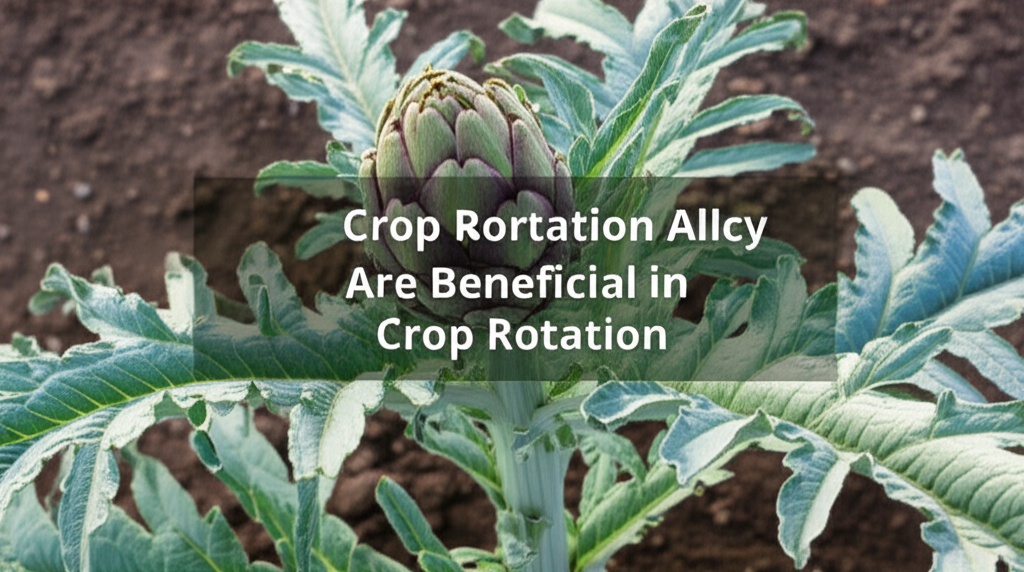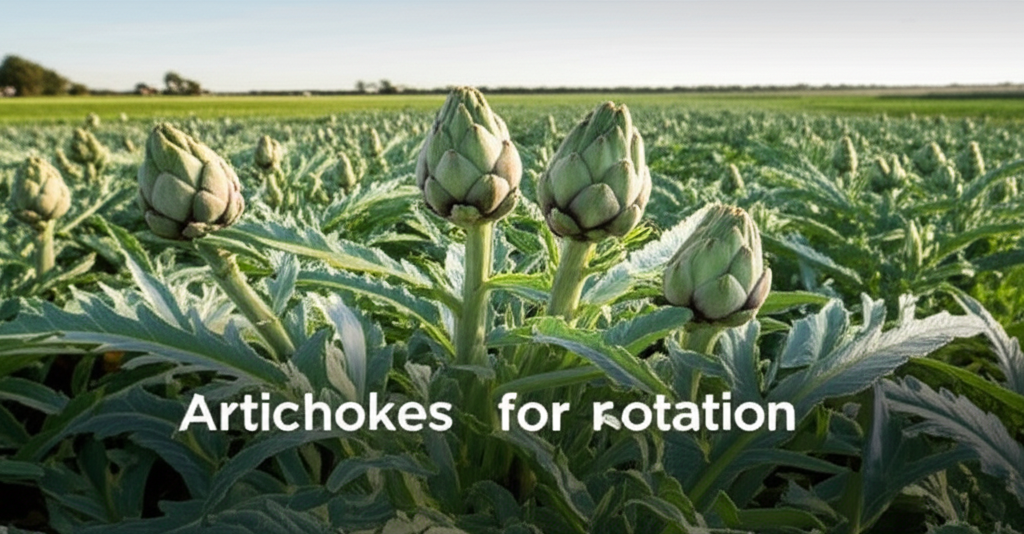The Underrated Powerhouse: Globe Artichokes in Sustainable Agriculture
The world of agriculture is constantly seeking methods to improve soil health, increase yields, and reduce reliance on synthetic inputs. Crop rotation, a time-tested practice, is a cornerstone of sustainable farming. While common rotation crops like legumes and cover crops are well-recognized, the humble globe artichoke (Cynara cardunculus var. scolymus) often gets overlooked. This article delves into the multifaceted benefits of incorporating globe artichokes into crop rotation systems, revealing their surprising contributions to soil fertility, pest management, and overall farm resilience.
Understanding Crop Rotation: A Foundation for Soil Health

Before we explore the specific advantages of artichokes, it’s crucial to understand why crop rotation is so vital. Simply put, crop rotation is the practice of planting different types of crops in the same area over a sequence of growing seasons. This prevents the buildup of soil-borne diseases and pests that are specific to certain plant families, breaks pest and disease cycles, and helps to manage nutrient levels in the soil.
Key Principles of Effective Crop Rotation:
- Nutrient Management: Different crops have varying nutrient requirements and uptake patterns. Rotating crops helps to balance nutrient levels, preventing depletion of specific elements.
- Pest and Disease Control: Many pests and diseases are host-specific. Rotating away from susceptible crops starves these populations, reducing the need for chemical interventions.
- Weed Suppression: Different crop structures and growth habits can outcompete or suppress different types of weeds.
- Soil Structure Improvement: Root systems vary significantly between crops, impacting soil aeration, water infiltration, and organic matter content.
- Risk Diversification: Planting a variety of crops reduces the risk of total crop failure due to specific environmental conditions or market fluctuations.
Globe Artichokes: A Deep Dive into Their Agricultural Attributes
Globe artichokes are perennial herbaceous plants belonging to the Asteraceae family. They are known for their edible flower buds, which are prized in culinary circles. However, their agricultural value extends far beyond their delicious florets. Their unique growth habit and biological characteristics make them an excellent, albeit unconventional, addition to crop rotation schemes.
Table 1: Key Facts and Comparison of Globe Artichokes in Rotation
| Feature | Globe Artichoke | Typical Rotation Crop (e.g., Legume) | Typical Rotation Crop (e.g., Root Vegetable) |
|---|---|---|---|
| Plant Type | Perennial | Annual | Annual |
| Root System | Deep taproot, extensive fibrous roots | Varied (fibrous or taproot) | Varied (taproot or fibrous) |
| Nitrogen Fixation | No | Yes (for legumes) | No |
| Soil Aeration | Excellent (due to deep roots) | Moderate | Good (depending on crop) |
| Organic Matter Contribution | High (perennial biomass) | Moderate (annual residue) | Moderate (annual residue) |
| Pest/Disease Specificity | Lower compared to annuals, but susceptible to some | Can be host for specific pests/diseases | Can be host for specific pests/diseases |
| Weed Suppression | Strong (due to dense foliage) | Variable | Variable |
The Multifaceted Benefits of Artichokes in Crop Rotation
The inclusion of globe artichokes in a rotation plan offers a suite of benefits that can significantly enhance the long-term productivity and health of agricultural land. These advantages stem from their perennial nature, deep root systems, and dense vegetative growth.
1. Enhancing Soil Structure and Health Through Deep Rooting
One of the most significant contributions of globe artichokes to crop rotation lies in their robust root systems. Artichokes develop a deep taproot that can penetrate the soil to considerable depths, often exceeding a meter. This extensive root network acts like natural subsoilers, breaking up compacted soil layers that can impede water infiltration and root growth of subsequent crops.
- Improved Drainage: The channels created by decaying artichoke roots enhance water percolation, reducing waterlogging and improving aeration.
- Increased Water Retention: Deeper root penetration allows plants to access moisture from deeper soil profiles, making them more resilient to drought.
- Enhanced Nutrient Cycling: The deep roots can bring up nutrients from lower soil horizons that might otherwise be unavailable to shallower-rooted crops. As the roots decompose, these nutrients are released into the upper soil layers.
- Increased Soil Organic Matter: The substantial biomass produced by artichokes, both above and below ground, contributes significantly to soil organic matter content when incorporated back into the soil. This organic matter improves soil structure, water-holding capacity, and microbial activity.
2. Natural Pest and Disease Management
While globe artichokes themselves can be susceptible to certain pests and diseases (such as aphids, slugs, and certain fungal infections), their role in a rotation can be strategically managed to disrupt the life cycles of common agricultural pests and pathogens. As a perennial, they are typically planted for several years, meaning their integration needs careful planning to avoid becoming a reservoir for problematic organisms. However, when used judiciously, they can offer advantages:
- Disruption of Annual Pest Cycles: By planting artichokes for a few years, you effectively remove the preferred hosts for many annual pests that plague common vegetable rotations. This can lead to a significant reduction in pest populations when you return to annual cropping.
- Attraction of Beneficial Insects: The flowering artichoke heads, when allowed to bloom, can attract a variety of beneficial insects, including pollinators and predatory insects that can help control pest populations in surrounding crops.
- Intercropping Potential: While not strictly rotation, intercropping artichokes with other plants can provide habitat and food sources for beneficial insects.
3. Weed Suppression Capabilities
Globe artichokes are vigorous growers with large, dense foliage that can effectively shade out and suppress many common weeds. This weed-suppressing capability is particularly valuable in organic farming systems where chemical weed control is avoided.
- Reduced Competition: By outcompeting weeds for sunlight, water, and nutrients, artichokes can reduce the weed seed bank in the soil.
- Improved Soil Cover: The dense canopy of artichoke plants helps to prevent weed seeds from germinating by blocking sunlight.
- Reduced Labor for Weed Control: In established artichoke patches, the need for manual or mechanical weeding can be significantly reduced.
4. Contribution to Biodiversity and Ecosystem Services
Incorporating a perennial crop like the globe artichoke into an annual cropping system adds a valuable layer of biodiversity.
- Habitat for Wildlife: Established artichoke patches can provide habitat and shelter for beneficial insects, small animals, and birds, contributing to a more balanced farm ecosystem.
- Pollinator Support: The large, nectar-rich flowers are highly attractive to bees and other pollinators, supporting their populations which are crucial for many agricultural crops.
- Reduced Soil Erosion: The extensive root system and dense foliage of artichokes help to stabilize the soil, significantly reducing erosion caused by wind and rain, especially compared to bare soil or sparsely planted crops.
Designing an Artichoke-Inclusive Crop Rotation Plan
Integrating a perennial crop like globe artichokes into a rotation requires a different mindset than planning for annuals. They are typically planted for 3-5 years before being replaced. Their placement within a rotation should be strategic, considering the needs of the crops that will follow them.
Table 2: Steps and Considerations for Artichoke Integration in Rotation (Pros/Cons)
| Step/Consideration | Description | Pros | Cons |
|---|---|---|---|
| Site Selection | Choose well-drained soil with good sunlight exposure. Avoid areas prone to flooding or heavy compaction. | Optimizes artichoke growth; reduces disease risk. | May limit rotation options if ideal sites are scarce. |
| Planting & Establishment | Artichokes can be started from seed or divisions. Proper spacing is crucial for air circulation. | Establishes a long-term crop; initial investment in plants. | Takes 1-2 years to reach full production; requires initial care. |
| Rotation Placement (Before Artichokes) | Follow crops that benefit from soil improvement, such as those that deplete nutrients or compact soil. | Prepares soil for artichoke establishment; utilizes previous crop’s benefits. | May require nutrient replenishment before planting artichokes. |
| Rotation Placement (After Artichokes) | Follow with crops that benefit from improved soil structure and fertility. Avoid crops highly susceptible to diseases that might affect artichokes if management is poor. | Leverages soil improvements; potentially higher yields. | Need to manage potential carryover of artichoke-specific pests/diseases; break crops may be needed. |
| Soil Amendment & Management | Incorporate compost annually, especially after harvest. Manage weeds and monitor for pests. | Maintains artichoke health and soil fertility; enhances benefits. | Requires ongoing management; can be labor-intensive. |
| Removal & Transition | Careful removal of root systems is important to prevent regrowth and prepare for subsequent crops. | Clean break for next rotation phase. | Can be labor-intensive to fully remove plants and roots. |
Potential Rotation Sequences:
Consider these examples:
- Year 1-4: Globe Artichokes
- Year 5: Cover Crop (e.g., buckwheat, clover) to scavenge remaining nutrients and further improve soil.
- Year 6: Deep-rooted cover crop (e.g., daikon radish) to further break up any remaining compaction.
- Year 7-9: Annual vegetables (e.g., brassicas, tomatoes, beans), benefiting from the improved soil.
Alternatively:
- Year 1-3: Legumes (e.g., peas, beans) to fix nitrogen.
- Year 4-6: Globe Artichokes to build soil structure and organic matter.
- Year 7: Leafy greens (e.g., lettuce, spinach) that appreciate well-structured, fertile soil.
- Year 8: Root vegetables (e.g., carrots, potatoes) to utilize the loosened soil profile.
Challenges and Considerations
While the benefits are substantial, integrating globe artichokes requires careful planning.
1. Perennial Nature and Field Management:
As perennials, artichokes remain in the ground for multiple years. This means they occupy a field for a longer duration than annual crops, impacting the overall rotation cycle. Their removal can also be labor-intensive, requiring significant effort to fully extract the extensive root system to prevent unwanted regrowth.
2. Specific Pest and Disease Management:
While they can disrupt annual pest cycles, artichokes are susceptible to their own set of pests and diseases, such as artichoke plume moth, aphids, slugs, and fungal issues like rust. Without proper management, an artichoke patch could become a reservoir for these problems, negatively impacting subsequent crops.
3. Nutrient Requirements:
Although they improve soil, artichokes are also relatively heavy feeders, especially during their productive years. They benefit greatly from regular applications of compost or well-rotted manure. If not managed adequately, they could deplete soil nutrients, requiring more intensive replenishment before the next crop in the rotation.
4. Economic Viability:
The primary reason artichokes are not more common in rotations is their limited annual yield and the time it takes for plants to reach full production. Farmers need to weigh the long-term soil benefits against the immediate economic returns and the labor involved in establishment and removal.
Conclusion: A Thorny Path to Sustainable Farming
Globe artichokes, with their deep root systems, robust foliage, and perennial nature, offer a unique and potent set of benefits when strategically incorporated into crop rotation plans. They are natural soil builders, enhancing structure, aeration, and organic matter content. Their dense growth aids in weed suppression, and their presence can contribute to a more biodiverse and resilient farm ecosystem.
While challenges exist regarding their perennial nature and specific management needs, the long-term rewards for soil health and farm sustainability are undeniable. For farmers looking to move beyond conventional annual rotations and embrace a more holistic approach to soil management, exploring the inclusion of globe artichokes could be a thorny, yet ultimately rewarding, path to a more productive and resilient agricultural future. By understanding their attributes and planning their integration thoughtfully, growers can unlock the hidden potential of this often-overlooked crop.


